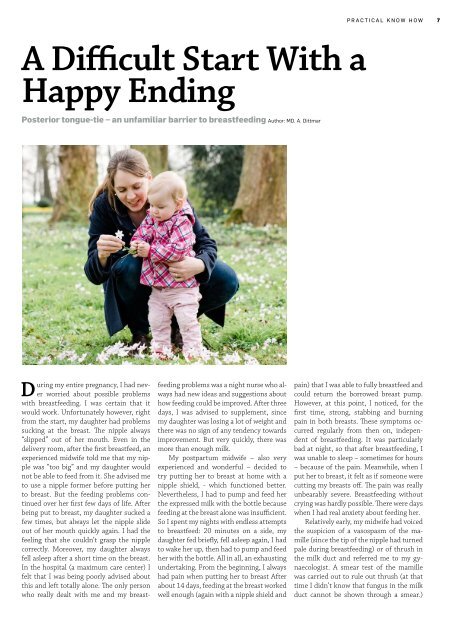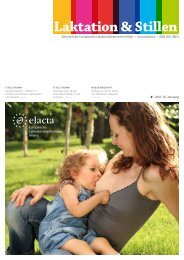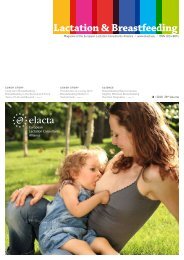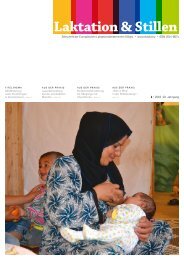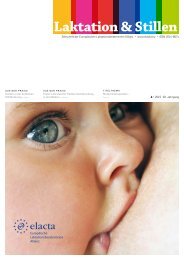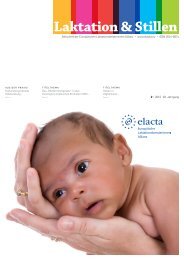Laktation_und_Stillen_2016-2 EN p1-8 web
You also want an ePaper? Increase the reach of your titles
YUMPU automatically turns print PDFs into web optimized ePapers that Google loves.
PRACTICAL KNOW HOW<br />
7<br />
A Difficult Start With a<br />
Happy Ending<br />
Posterior tongue-tie – an unfamiliar barrier to breastfeeding Author: MD. A. Dittmar<br />
During my entire pregnancy, I had never<br />
worried about possible problems<br />
with breastfeeding. I was certain that it<br />
would work. Unfortunately however, right<br />
from the start, my daughter had problems<br />
sucking at the breast. The nipple always<br />
“slipped” out of her mouth. Even in the<br />
delivery room, after the first breastfeed, an<br />
experienced midwife told me that my nipple<br />
was “too big” and my daughter would<br />
not be able to feed from it. She advised me<br />
to use a nipple former before putting her<br />
to breast. But the feeding problems continued<br />
over her first few days of life. After<br />
being put to breast, my daughter sucked a<br />
few times, but always let the nipple slide<br />
out of her mouth quickly again. I had the<br />
feeling that she couldn’t grasp the nipple<br />
correctly. Moreover, my daughter always<br />
fell asleep after a short time on the breast.<br />
In the hospital (a maximum care center) I<br />
felt that I was being poorly advised about<br />
this and left totally alone. The only person<br />
who really dealt with me and my breastfeeding<br />
problems was a night nurse who always<br />
had new ideas and suggestions about<br />
how feeding could be improved. After three<br />
days, I was advised to supplement, since<br />
my daughter was losing a lot of weight and<br />
there was no sign of any tendency towards<br />
improvement. But very quickly, there was<br />
more than enough milk.<br />
My postpartum midwife – also very<br />
experienced and wonderful – decided to<br />
try putting her to breast at home with a<br />
nipple shield, - which functioned better.<br />
Nevertheless, I had to pump and feed her<br />
the expressed milk with the bottle because<br />
feeding at the breast alone was insufficient.<br />
So I spent my nights with endless attempts<br />
to breastfeed: 20 minutes on a side, my<br />
daughter fed briefly, fell asleep again, I had<br />
to wake her up, then had to pump and feed<br />
her with the bottle. All in all, an exhausting<br />
<strong>und</strong>ertaking. From the beginning, I always<br />
had pain when putting her to breast After<br />
about 14 days, feeding at the breast worked<br />
well enough (again with a nipple shield and<br />
pain) that I was able to fully breastfeed and<br />
could return the borrowed breast pump.<br />
However, at this point, I noticed, for the<br />
first time, strong, stabbing and burning<br />
pain in both breasts. These symptoms occurred<br />
regularly from then on, independent<br />
of breastfeeding. It was particularly<br />
bad at night, so that after breastfeeding, I<br />
was unable to sleep – sometimes for hours<br />
– because of the pain. Meanwhile, when I<br />
put her to breast, it felt as if someone were<br />
cutting my breasts off. The pain was really<br />
unbearably severe. Breastfeeding without<br />
crying was hardly possible. There were days<br />
when I had real anxiety about feeding her.<br />
Relatively early, my midwife had voiced<br />
the suspicion of a vasospasm of the mamille<br />
(since the tip of the nipple had turned<br />
pale during breastfeeding) or of thrush in<br />
the milk duct and referred me to my gynaecologist.<br />
A smear test of the mamille<br />
was carried out to rule out thrush (at that<br />
time I didn’t know that fungus in the milk<br />
duct cannot be shown through a smear.)


